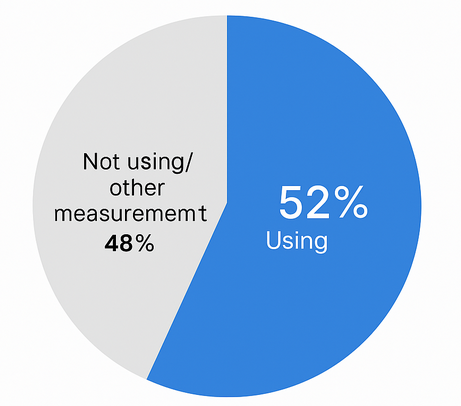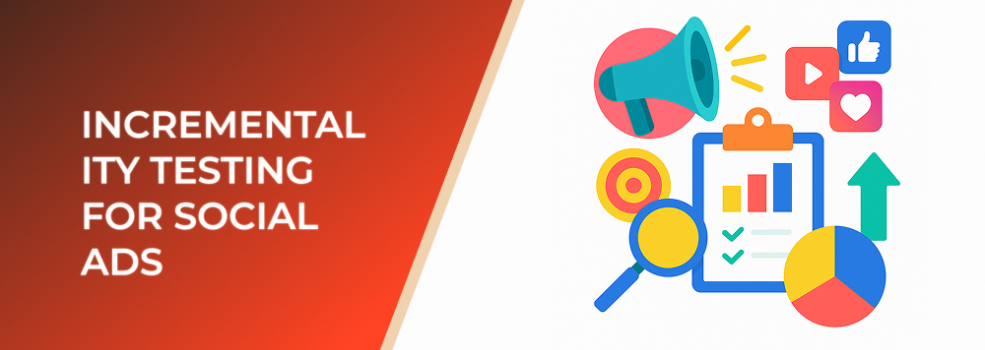Marketers often see strong performance metrics from their social advertising campaigns, yet many still struggle with a fundamental question: How much of this impact is truly caused by the ads? Incrementality testing answers this by measuring the real lift generated beyond what would have happened organically. As ad platforms become increasingly automated and privacy regulations change how attribution works, incrementality testing has become one of the most reliable methods for validating campaign effectiveness.

Share of marketers using incrementality testing/experiments (US, 2025)
Industry surveys show that more than 60 percent of digital marketers cite measurement accuracy as their biggest challenge, and nearly half of advertisers have adopted some form of incrementality testing to validate their return on ad spend. With ad costs rising and competition tightening, understanding true incremental impact is more important than ever.
What Incrementality Testing Measures
Incrementality testing compares outcomes between a group exposed to ads and a control group that is intentionally held out. By isolating these two audiences, marketers can identify the difference in conversions, revenue, or other KPIs that can be directly attributed to advertising.
Key insights include:
-
Whether ads are generating net-new conversions
-
How different audience segments respond to advertising
-
The additional revenue produced by specific campaigns
-
Which channels and creatives contribute the most to real lift

Typical efficiency gains after applying incrementality-based optimization
A recent analysis across multiple e-commerce advertisers found that up to 30 percent of attributed conversions would have happened without paid media. This reinforces the need to validate assumptions rather than relying solely on platform-reported data.
Common Methods of Incrementality Testing
Several testing approaches help marketers design the most accurate experiments possible.
Geo-Based Testing
This method compares performance across regions. One set of geographic areas receives the ad campaign, while others are held out. Geo tests are particularly effective for large-scale campaigns and can remain stable despite user-level privacy limitations.
Audience Split Testing
Audiences are randomly divided into test and control groups. Those in the test group see the ads, while the control group is intentionally excluded. This method provides high accuracy when the audience size is large enough.
Time-Based Testing
In certain cases, campaigns can be turned on and off at scheduled intervals to track how performance changes. Although useful in specific scenarios, this method is more susceptible to external factors such as seasonality and trends.
Why Incrementality Matters Now
The combination of increasing competition, privacy restrictions, and changes to tracking technologies has made traditional attribution less reliable. Incrementality offers a clearer view by focusing on cause-and-effect, not assumption-based correlation.
Key reasons it matters today:
-
Rising acquisition costs require verified ROI
-
Platform metrics often overstate paid impact
-
Accurate measurement prevents overspending on non-incremental audiences
-
Data-driven budgeting improves long-term advertising efficiency
In fact, studies show that businesses reallocating budget based on incrementality insights commonly achieve 10 to 25 percent improvement in cost efficiency.
How to Implement Incrementality Testing
Successful incrementality testing relies on disciplined setup and careful analysis.
Define Clear KPIs
Choose metrics such as conversions, revenue, subscription starts, or lead quality. These will anchor the experiment.
Create Statistically Valid Groups
Randomization and proper audience allocation are essential for reliable results. Ensure the control group is large enough to compare outcomes confidently.
Run Tests for Long Enough
Short tests risk capturing temporary fluctuations. Many advertisers run tests for two to six weeks, depending on campaign volume.
Analyze Lift and Take Action
Once the test concludes, compare outcomes and calculate incremental lift. Use the findings to adjust budgets, pause low-impact campaigns, or scale high-performing segments.
Conclusion
Incrementality testing is a powerful tool for validating social ad performance, reducing wasted spend, and improving long-term growth. By understanding true cause-and-effect, marketers can prioritize strategies that generate real business impact and make more effective decisions.
Further Reading
For more insights, explore these related articles:
-
Audience Targeting Strategies for Better Campaign Results
-
Lookalike Modeling: How to Extend Your Best Customer Segments
-
The Role of Multi-Channel Attribution in Modern Advertising

